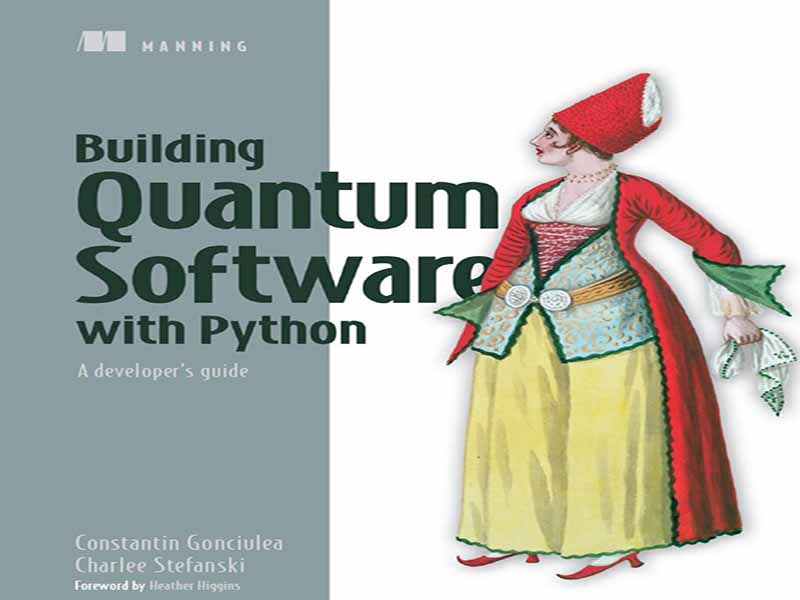- عنوان کتاب: Building Quantum Software in Python
- نویسنده: Constantin Gonciulea, Charlee Stefanski
- حوزه: برنامه نویسی کوانتومی
- سال انتشار: 2025
- تعداد صفحه: 378
- زبان اصلی: انگلیسی
- نوع فایل: pdf
- حجم فایل: 6.16 مگابایت
آینده محاسبات کوانتومی نه تنها در دستان فیزیکدانان کوانتومی، بلکه در دستان توسعهدهندگان نرمافزاری است که راهحلهای کوانتومی را در برنامههای کاربردی اصلی ادغام خواهند کرد. انگیزه این کتاب از تجربیات در دو موسسه مالی نشأت گرفته است، جایی که مشخص شد توسعهدهندگان نقش محوری در ایجاد و پذیرش برنامههای کاربردی محاسبات کوانتومی عملی و واقعی خواهند داشت. یک تصور غلط رایج این است که محاسبات کوانتومی نیاز به پیشینه فیزیک یا ریاضیات پیشرفته دارد. در واقع، توسعهدهندگان از قبل دانش زیادی برای درک و کار با محاسبات کوانتومی دارند. چالش، پیچیدگی ریاضی نیست، بلکه اتصال مفاهیم محاسباتی آشنا به اصول «عجیب» محاسبات کوانتومی است. این پیام اصلی این کتاب است. ما این پل را از طریق نمایشهای بصری گسترده و با تمرکز بر ساختارهای محاسباتی که مزایای منحصر به فرد محاسبات کوانتومی را نشان میدهند، میسازیم. به طور خاص، ساختارهای موج مانند با الگوهای تناوبی نشان میدهند که رویکردهای کوانتومی در کجا به طور چشمگیری از رویکردهای کلاسیک پیشی میگیرند. این سیگنالهای تناوبی، پیادهسازیهای کوانتومی «به طرز شرمآوری موازی» را امکانپذیر میکنند، که در آن حداکثر تعداد عملیات به طور همزمان رخ میدهد. تبدیل فوریه – ابزاری اساسی برای کار با سیگنالهای تناوبی – سنگ بنای بسیاری از الگوریتمهای کوانتومی، از جمله الگوریتم معروف فاکتورگیری شور است. اگرچه ما الگوریتم شور را پوشش نمیدهیم، اما این کتاب شما را از طریق رمزگذاری توابع چندجملهای به عنوان حالتهای کوانتومی و استخراج اطلاعات از آنها، به سمت اصول مشابه هدایت میکند. این قابلیت، دریچهای را برای حل مسائل بهینهسازی که در بسیاری از حوزهها ظاهر میشوند، باز میکند. در طول مسیر، شما بر مبانی محاسبات کوانتومی، الگوریتمهای اساسی و پیادهسازی توزیعهای احتمال مختلف برای نمونهبرداری تصادفی کارآمد تسلط خواهید یافت. برای اطمینان از ماندگاری کتاب، از پیوند دادن آن به هر چارچوب محاسبات کوانتومی خاصی خودداری کردهایم. در عوض، ما چارچوب حداقلی خودمان را در چند صد خط کد میسازیم. این رویکرد دو هدف را دنبال میکند: درک شما از مفاهیم کوانتومی را عمیقتر میکند و یک پیادهسازی عملی ارائه میدهد که با Qiskit شرکت IBM، محبوبترین چارچوب محاسبات کوانتومی، سازگار است. ما این سازگاری را در مخازن خود حفظ میکنیم و اطمینان حاصل میکنیم که مهارتهایی که یاد میگیرید با تکامل محاسبات کوانتومی مرتبط باقی میمانند.
The future of quantum computing lies not just in the hands of quantum physicists but also in those of software developers who will integrate quantum solutions into mainstream applications. The motivation for this book grew from experiences at two financial institutions, where it became clear that developers will be central to the creation and adoption of practical, real-world quantum computing applications. A common misconception is that quantum computing requires an advanced physics or mathematics background. In reality, developers already possess much of the knowledge needed to understand and work with quantum computing. The challenge is not mathematical complexity but connecting familiar computing concepts to quantum computing’s “strange” principles. This is the core message of this book. We build this bridge through extensive visual representations and by focusing on computational structures that showcase quantum computing’s unique advantages. Wave-like structures with periodic patterns, in particular, demonstrate where quantum approaches dramatically outperform classical ones. These periodic signals enable “embarrassingly parallel” quantum implementations, where a maximum number of operations occur simultaneously. The Fourier transform—a fundamental tool for working with periodic signals—is the cornerstone of many quantum algorithms, including Shor’s famous factorization algorithm. Although we don’t cover Shor’s algorithm, this book guides you toward similar principles through encoding polynomial functions as quantum states and extracting information from them. This capability opens the door to solving optimization problems that appear across many domains. Along the way, you’ll master quantum computing foundations, fundamental algorithms, and implementations of various probability distributions for efficient random sampling. To ensure the book’s longevity, we’ve avoided tying it to any particular quantum computing framework. Instead, we build our own minimal framework in a few hundred lines of code. This approach serves two purposes: it deepens your understanding of quantum concepts, and it provides a practical implementation that’s interfacecompatible with IBM’s Qiskit, the most popular quantum computing framework. We maintain this compatibility in our repositories, ensuring that the skills you learn remain relevant as quantum computing evolves.
این کتاب را میتوانید از لینک زیر بصورت رایگان دانلود کنید:
Download: Building Quantum Software in Python




































نظرات کاربران